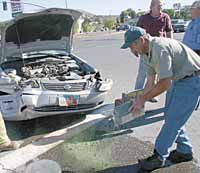| Emergency personnel clean up oil and antifreeze after a no injury traffic accident occurred at the intersection of Carbonville Road and 100 North last Thursday. Based on statistics gathered by local officials, Carbonville Road is the location of the highest percentage of local traffic accidents in terms of property damage and injuries. A new signage program currently underway may help reduce the accident rates in the area. |
Regulatory and warning signs placed alongside roads affect the safety of the byways.
The fact has been shown by data compiled in connection with a special signage program that Medocino County in California has been participating in for the last 10 years.
During the time period, the northern California county has been able to reduce the accident volume on roads by 42 percent. The Medocino County Department of Transportation is responsible for more than 1,000 miles of roads that serve 87,000 residents.
Carbon County has a chance to pick up on that safety improvement record because the Utah Department of Transportation has selected Castle Valley to participate in a prototype program to emulate the California experience.
“Looking at what has been done in California, I think this could really help our accident situation on county roads,” commented Larry Prettyman, Carbon’s safety coordinator. “They picked only two counties in Utah to test the program, us and Summit, so I think we are pretty lucky.”
Carbon has more than 500 miles of county roads, pointed out Prettyman. The county will be lent the services of a sign engineer who will survey the byways and decide where new signage is important. A private contractor will install the signs in the designated areas. The cost of the effort will be shared by the county and the state, with Utah paying 90 percent of the price of the signs.
“After the installation, the state will work with local law enforcement to track accident location with geographic positioning systems and they will monitor the success of the program as far as accident reduction by comparing it with the county’s numbers for the past three years,” stated Prettyman.
Earlier in the summer, Prettyman worked with the Carbon County Sheriff’s Office to compile a log of accidents. The data included the locations along with the costs in terms of property damage and injury/death statistics related to accidents occurring on county roads from January 2001 through May 2004.
The study showed that Carbonville Road had the highest accident rate. More than 70 mishaps occurred on the road during the time period, with the accidents resulting in $178,000 in damage, eight injuries and one death.
Next in line is old Wellington Road, with 14 accidents, almost $43,000 in damage and four injuries.
Altogether county roads accounted for $739,419 in damages, 35 injuries and three deaths in those three years.
Prettyman said the idea for the program got started when he went to a road school in
St. George in April he was told about some funding that had been available to repair dangerous roads in the state.
“I was told that most of the large northern Utah counties know about funding options for repairing dangerous roads that many of the rural counties don’t,” says Prettyman. “When I talked with them about funding they told me I needed to get some data about our situation together. After working with the Sheriffs staff and putting together the information the state came down and suggested we look at this signage funding option..”
Prettyman said that he worked with Brad McCourt, the county’s assistant road supervisor who is also responsible for sign installation and maintenance records, who thought the program could reduce accidents and also reduce the county’s liability. Then the state decided to send Prettyman and McCourt to California next week to meet with Medocino County officials so they can learn from that county’s experience.
The plan for the improvements has been reviewed by Commissioner Bill Krompel and county road supervisor Ray Hanson.
Road surveys for deciding where new signage is needed should begin in October.

